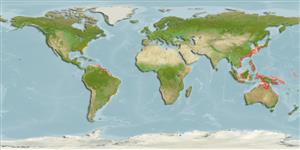Teleostei (teleosts) >
Gobiiformes (Gobies) >
Gobiidae (Gobies) > Gobiinae
Etymology: Discordipinna: Latin, discors = to disagree + Latin, pinna = fin, wing (Ref. 45335); filamentosa: Name from Latin 'filamentum' meaning the thread-like elongation of fin; referring to its diagnostic feature, the very thin and long extension of the anterior two spinous rays of first dorsal fin.
Environment: milieu / climate zone / depth range / distribution range
Ecology
Marine; reef-associated; depth range 30 - 82 m (Ref. 90871). Subtropical
Western Pacific: Japan and Malaysia.
Size / Weight / Age
Maturity: Lm ? range ? - ? cm
Max length : 1.6 cm SL male/unsexed; (Ref. 90871)
Short description
Identification keys | Morphology | Morphometrics
Dorsal spines (total): 7; Dorsal soft rays (total): 8; Anal spines: 1; Anal soft rays: 8; Vertebrae: 26. Discordipinna filamentosa can be distinguished from D. griessingeri by the following unique set of features: D VI (vs. V), first dorsal fin with the longest, filamentous first ray in male extending far beyond caudal fin base when depressed (vs. second ray of dorsal-fin base longest in male); pectoral fin rays 16 (vs. 17-20); longitudinal scale rows 26; predorsal naked; transverse scale rows 8; dorsal pterygiophore formulae 3/122101/9 (vs. 3/41001/8); vertebrae 10 + 16 = 26; with loosely arranged, longitudinal pattern of infraorbital papilla and anterior oculoscapular canal present (with median pore ? singular on middle of interorbital region, lateral section as pores ?, ? and ?) and preopercular canal (with three pores ?, ? and ?), lacking posterior oculoscapular canal; body generally creamy white; head with a snow-white oblique band from upper lip to upper part of opercle; scattered tiny, densely-set tiny orange to brown spots on dorsal side of snout; 3 lateral, oblique orange to brown bands which generally fused ventrally on trunk; lateral body with 4-5 thin longitudinal yellow stripes; first dorsal fin yellow with 12 major transverse deep brown bands mainly on filamentous portion of the fin (vs. entirely orange red) and an oval translucent mark on basal portion of that; second dorsal fin yellow with about 4 rounded gray blotches each having a central deep black spot against yellow background; caudal fin yellow with a shallow 'C' shaped snow white mark basally and several round deep black spots on upper half; anal and pelvic fins are entirely deep black (vs. with lower 2/3 region orange red and upper 1/3 region translucent); pectoral fin with a snow-white wedge (Ref. 90871).
Collected from the deepwater trawling of up to 82 m. Observed through scuba diving and current trawl specimen record, that the species seems to live in 30 to 82 m depth water with substratum of coral-reef hard debris (Ref. 90871).
Life cycle and mating behavior
Maturity | Reproduction | Spawning | Eggs | Fecundity | Larvae
Chen, I.-S., T. Suzuki and K.-T. Shao, 2012. A new deepwater goby of the genus Discordipinna Hoese & Fourmanoir, 1978 (Teleostei: Gobiidae) from Kumejima of the Ryukyus, Japan. Zootaxa 3367:274-280. (Ref. 90871)
IUCN Red List Status (Ref. 130435: Version 2024-2)
Threat to humans
Harmless
Human uses
Fisheries: bycatch
Tools
Special reports
Download XML
Internet sources
Estimates based on models
Preferred temperature (Ref.
123201): 21.7 - 28.1, mean 27.1 °C (based on 98 cells).
Phylogenetic diversity index (Ref.
82804): PD
50 = 0.7500 [Uniqueness, from 0.5 = low to 2.0 = high].
Bayesian length-weight: a=0.00724 (0.00339 - 0.01546), b=3.10 (2.92 - 3.28), in cm total length, based on LWR estimates for this (Sub)family-body shape (Ref.
93245).
Trophic level (Ref.
69278): 3.0 ±0.3 se; based on size and trophs of closest relatives
Resilience (Ref.
120179): High, minimum population doubling time less than 15 months (Preliminary K or Fecundity.).
Fishing Vulnerability (Ref.
59153): Low vulnerability (10 of 100).
